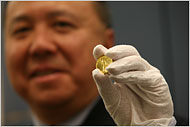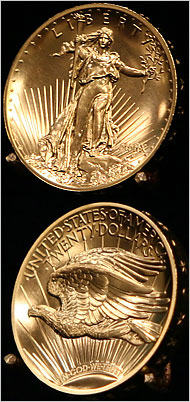
PREV ARTICLE
NEXT ARTICLE
FULL ISSUE
PREV FULL ISSUE
V11 2008 INDEX
E-SYLUM ARCHIVE
MINT DIRECTOR MOY STRIKES FIRST 2009 ULTRA-HIGH-RELIEF DOUBLE EAGLES
Artur Shippee forwarded an article from the November 24th
New York Times on the striking of the 2009 ultra-high-relief $20
gold coins using Augustus Saint-Gaudens' original 1907 designs. Wow - now
THAT'S a bullion coin worth having. -Editor
 With the push of a button and some 60 tons of
pressure, a blank gold disc was converted into an ultra-high-relief coin
at the branch of the United States Mint here Monday, and a century-old
vision for America.s coinage was finally fully realized.
With the push of a button and some 60 tons of
pressure, a blank gold disc was converted into an ultra-high-relief coin
at the branch of the United States Mint here Monday, and a century-old
vision for America.s coinage was finally fully realized.Producing the $20 coins, initially conceived by the American sculptor Augustus Saint-Gaudens in 1907, has been a personal goal of the mint.s director, Edmund C. Moy, since he was appointed in 2006. .Saint-Gaudens was a bit of a poet and wanted to tell a story,. Mr. Moy said at a ceremony Monday at the branch, where the new coin was first struck. .Liberty has visited America and is now marching into the rest of the world, led by enlightenment. America.s best days are ahead..
 In President Theodore Roosevelt.s opinion, those
ideals weren.t embodied by existing coins, and he commissioned his friend
Saint-Gaudens to come up with fresh designs.
In President Theodore Roosevelt.s opinion, those
ideals weren.t embodied by existing coins, and he commissioned his friend
Saint-Gaudens to come up with fresh designs. His vision for the coin, known as a double eagle (it was twice the value of the $10 coin known as the eagle), was hailed by Roosevelt and others as a classical masterpiece. A full figure representing Liberty strides toward the viewer, torch raised, hair flowing and robes billowing, one foot on a promontory while the sun rises over the Capitol dome behind her. The reverse shows an eagle in flight over a blazing sun. The coin.s mastery lay chiefly in two trademarks of the sculptor.s style, typical of his medals: the comparatively high relief and the graceful incorporation of lettering in the design.
But one crucial person was not enamored: Charles Barber, chief engraver of the United States Mint at the time and a designer himself of several coins then in circulation . those Roosevelt and much of the public so disliked. According to Alison Frankel.s 2006 book, .Double Eagle,. Barber fought for his turf and did little to smooth the way for Saint-Gaudens.s designs.
Barber.s main critique was that the coin.s exceptionally high relief made production impossibly slow and difficult, and he had a point. In early tests up to 11 strikes per coin were required to bring out all the details. A variation using a smaller but thicker blank had to be abandoned because such a change would need Congressional approval.
The newest coins, slightly more than an inch in diameter, use the smaller, thicker blanks rejected in 1907, are dated MMIX (2009), and contain exactly an ounce of 24-karat gold. The original coins were larger in size and contained 22-karat gold, hard enough to withstand circulation, but Mr. Moy, said modern investors prefer pure gold, which also has the benefit of being soft enough to turn into ultra-high relief coins.
The first $20 coin will be placed in the National Museum of American History of the Smithsonian Institution. The rest, which will be produced for only a year, go on sale to collectors and investors in January, at a price still to be determined, based largely on the current bullion price of gold. (On Monday afternoon it was about $824 an ounce in New York.)
Though the new coin is largely faithful to Saint-Gaudens.s vision, in one respect it won.t resemble the original: the reverse still reads .In God We Trust..
To read the complete article, see: Century Later, Gold Coin Reflects Sculptor.s Vision (http://www.nytimes.com/2008/11/25/arts/design/25coin.html?_r=1)
Wayne Homren, Editor
The Numismatic Bibliomania Society is a non-profit organization promoting numismatic literature. See our web site at coinbooks.org.
To submit items for publication in The E-Sylum, write to the Editor at this address: whomren@gmail.com
To subscribe go to: https://my.binhost.com/lists/listinfo/esylum
All Rights Reserved.
NBS Home Page
Contact the NBS webmaster
